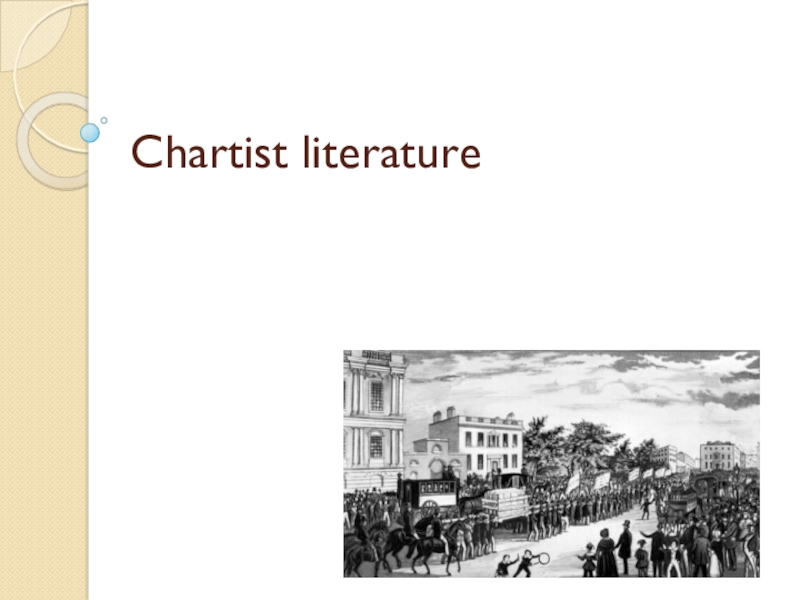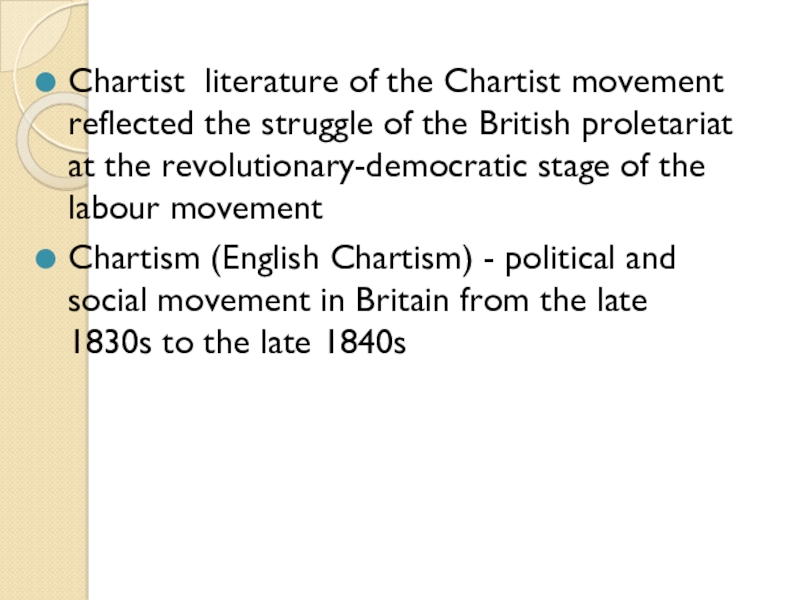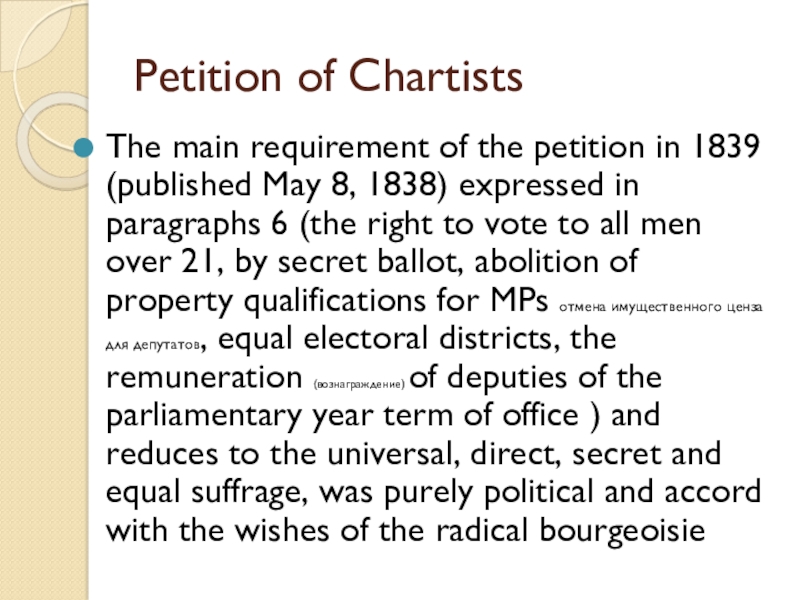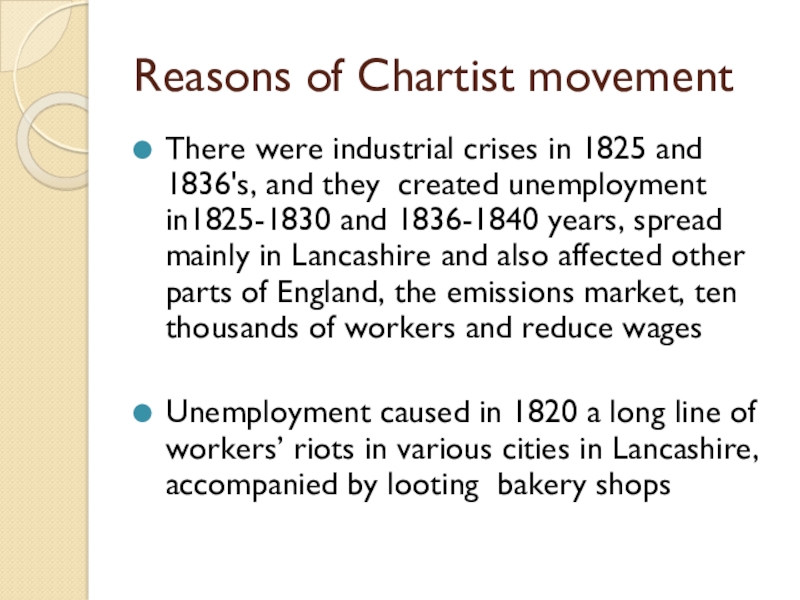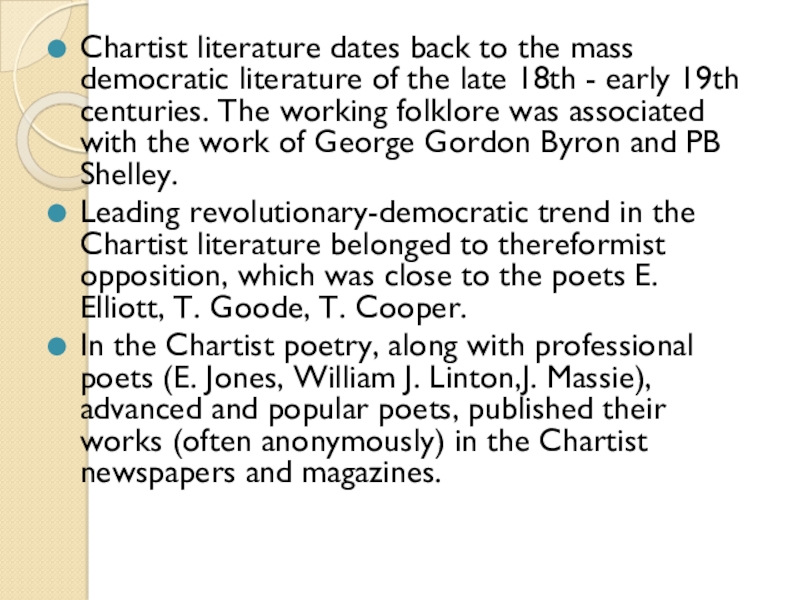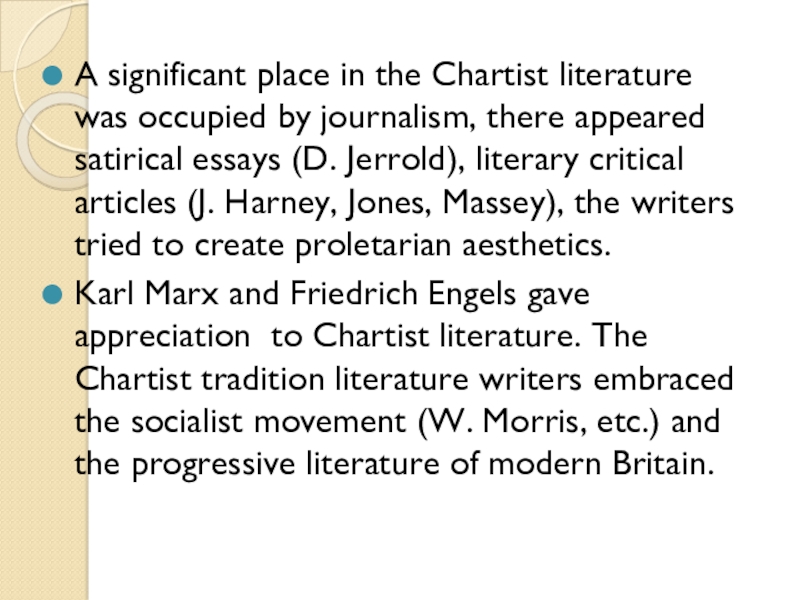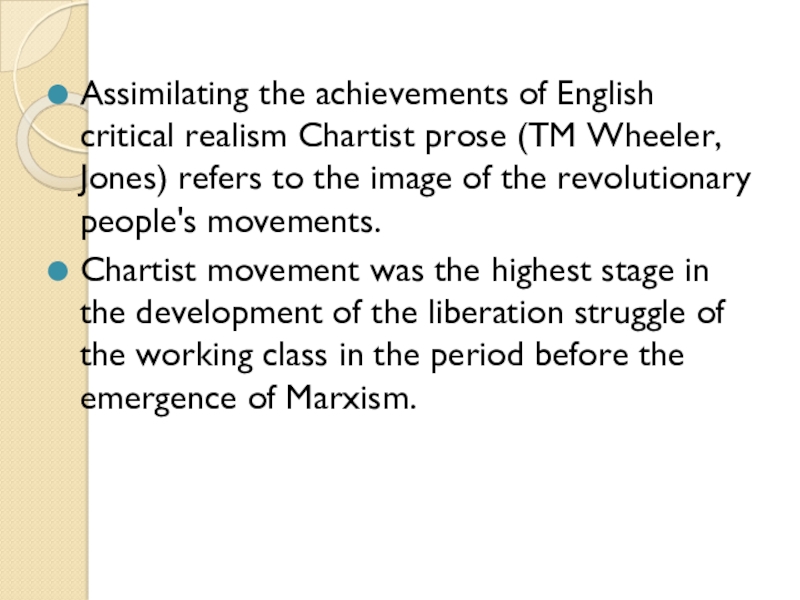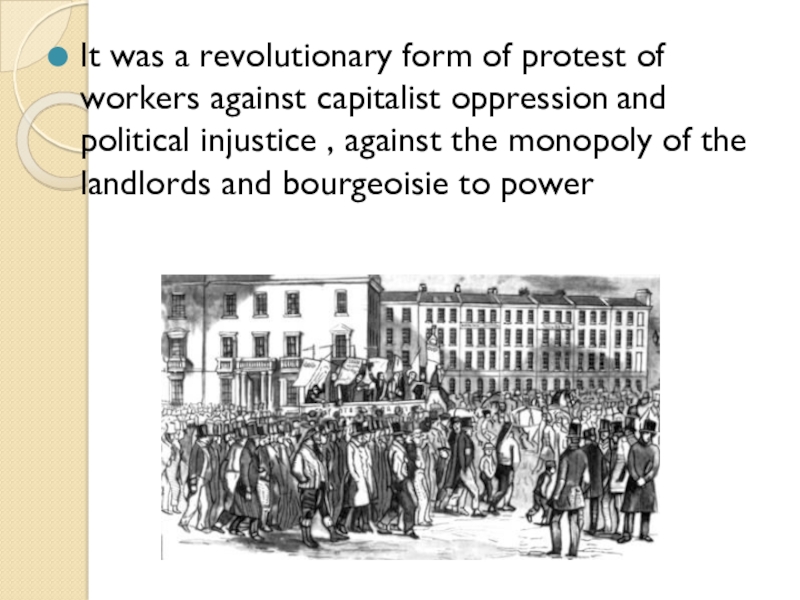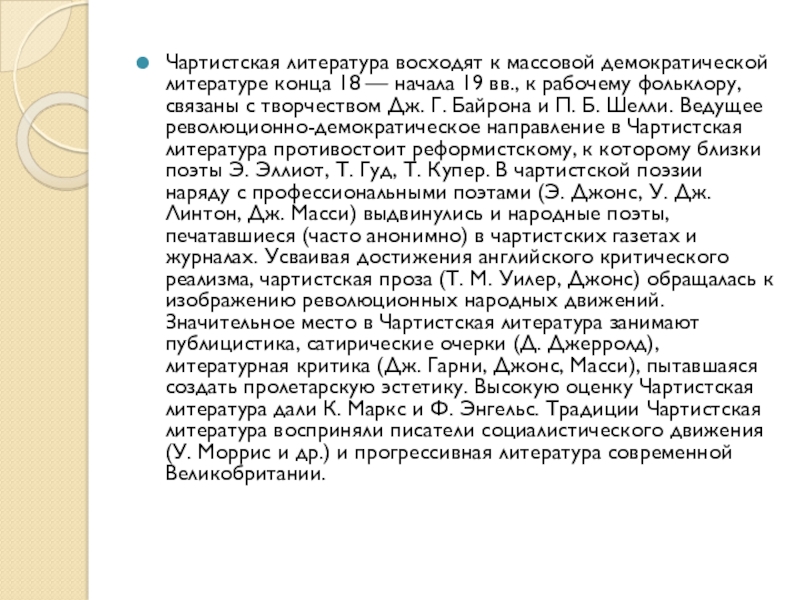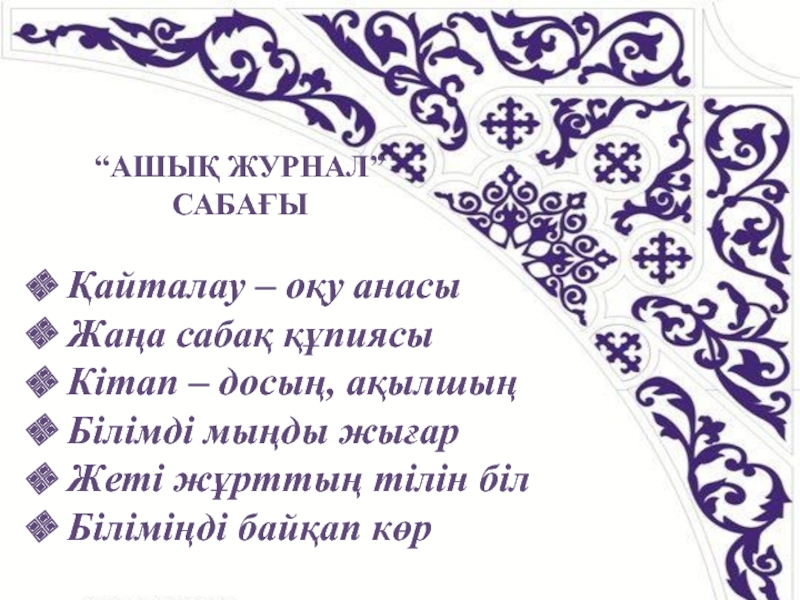- Главная
- Разное
- Образование
- Спорт
- Естествознание
- Природоведение
- Религиоведение
- Французский язык
- Черчение
- Английский язык
- Астрономия
- Алгебра
- Биология
- География
- Геометрия
- Детские презентации
- Информатика
- История
- Литература
- Математика
- Музыка
- МХК
- Немецкий язык
- ОБЖ
- Обществознание
- Окружающий мир
- Педагогика
- Русский язык
- Технология
- Физика
- Философия
- Химия
- Шаблоны, фоны, картинки для презентаций
- Экология
- Экономика
Презентация, доклад по англ. литературе на тему Chartist Literature
Содержание
- 1. Презентация по англ. литературе на тему Chartist Literature
- 2. Chartist literature of the Chartist movement reflected
- 3. Petition of ChartistsThe main requirement of the
- 4. Reasons of Chartist movementThere were industrial crises
- 5. Chartist literature dates back to the mass
- 6. A significant place in the Chartist literature
- 7. Assimilating the achievements of English critical realism
- 8. It was a revolutionary form of protest
- 9. Чартистская литература восходят к массовой демократической литературе
Chartist literature of the Chartist movement reflected the struggle of the British proletariat at the revolutionary-democratic stage of the labour movementChartism (English Chartism) - political and social movement in Britain from the late 1830s to the
Слайд 2Chartist literature of the Chartist movement reflected the struggle of the
British proletariat at the revolutionary-democratic stage of the labour movement
Chartism (English Chartism) - political and social movement in Britain from the late 1830s to the late 1840s
Chartism (English Chartism) - political and social movement in Britain from the late 1830s to the late 1840s
Слайд 3Petition of Chartists
The main requirement of the petition in 1839 (published
May 8, 1838) expressed in paragraphs 6 (the right to vote to all men over 21, by secret ballot, abolition of property qualifications for MPs отмена имущественного ценза для депутатов, equal electoral districts, the remuneration (вознаграждение) of deputies of the parliamentary year term of office ) and reduces to the universal, direct, secret and equal suffrage, was purely political and accord with the wishes of the radical bourgeoisie
Слайд 4Reasons of Chartist movement
There were industrial crises in 1825 and 1836's,
and they created unemployment in1825-1830 and 1836-1840 years, spread mainly in Lancashire and also affected other parts of England, the emissions market, ten thousands of workers and reduce wages
Unemployment caused in 1820 a long line of workers’ riots in various cities in Lancashire, accompanied by looting bakery shops
Unemployment caused in 1820 a long line of workers’ riots in various cities in Lancashire, accompanied by looting bakery shops
Слайд 5Chartist literature dates back to the mass democratic literature of the
late 18th - early 19th centuries. The working folklore was associated with the work of George Gordon Byron and PB Shelley.
Leading revolutionary-democratic trend in the Chartist literature belonged to thereformist opposition, which was close to the poets E. Elliott, T. Goode, T. Cooper.
In the Chartist poetry, along with professional poets (E. Jones, William J. Linton,J. Massie), advanced and popular poets, published their works (often anonymously) in the Chartist newspapers and magazines.
Leading revolutionary-democratic trend in the Chartist literature belonged to thereformist opposition, which was close to the poets E. Elliott, T. Goode, T. Cooper.
In the Chartist poetry, along with professional poets (E. Jones, William J. Linton,J. Massie), advanced and popular poets, published their works (often anonymously) in the Chartist newspapers and magazines.
Слайд 6A significant place in the Chartist literature was occupied by journalism,
there appeared satirical essays (D. Jerrold), literary critical articles (J. Harney, Jones, Massey), the writers tried to create proletarian aesthetics.
Karl Marx and Friedrich Engels gave appreciation to Chartist literature. The Chartist tradition literature writers embraced the socialist movement (W. Morris, etc.) and the progressive literature of modern Britain.
Karl Marx and Friedrich Engels gave appreciation to Chartist literature. The Chartist tradition literature writers embraced the socialist movement (W. Morris, etc.) and the progressive literature of modern Britain.
Слайд 7Assimilating the achievements of English critical realism Chartist prose (TM Wheeler,
Jones) refers to the image of the revolutionary people's movements.
Chartist movement was the highest stage in the development of the liberation struggle of the working class in the period before the emergence of Marxism.
Chartist movement was the highest stage in the development of the liberation struggle of the working class in the period before the emergence of Marxism.
Слайд 8It was a revolutionary form of protest of workers against capitalist
oppression and political injustice , against the monopoly of the landlords and bourgeoisie to power
Слайд 9Чартистская литература восходят к массовой демократической литературе конца 18 — начала
19 вв., к рабочему фольклору, связаны с творчеством Дж. Г. Байрона и П. Б. Шелли. Ведущее революционно-демократическое направление в Чартистская литература противостоит реформистскому, к которому близки поэты Э. Эллиот, Т. Гуд, Т. Купер. В чартистской поэзии наряду с профессиональными поэтами (Э. Джонс, У. Дж. Линтон, Дж. Масси) выдвинулись и народные поэты, печатавшиеся (часто анонимно) в чартистских газетах и журналах. Усваивая достижения английского критического реализма, чартистская проза (Т. М. Уилер, Джонс) обращалась к изображению революционных народных движений. Значительное место в Чартистская литература занимают публицистика, сатирические очерки (Д. Джерролд), литературная критика (Дж. Гарни, Джонс, Масси), пытавшаяся создать пролетарскую эстетику. Высокую оценку Чартистская литература дали К. Маркс и Ф. Энгельс. Традиции Чартистская литература восприняли писатели социалистического движения (У. Моррис и др.) и прогрессивная литература современной Великобритании.
